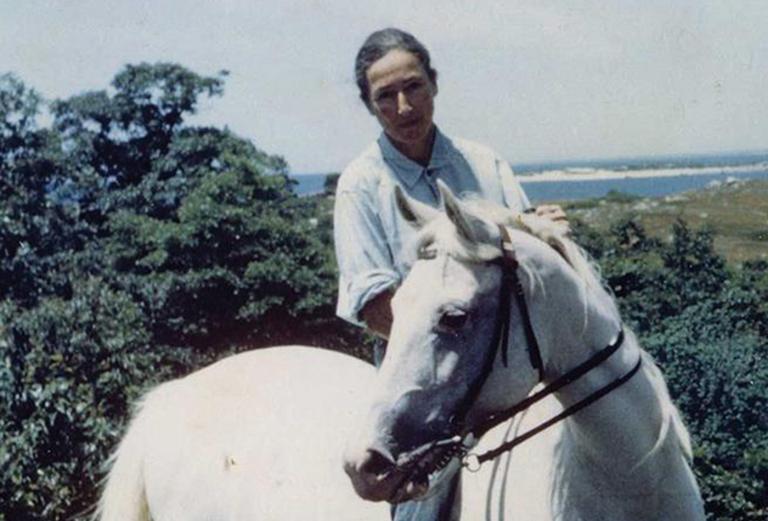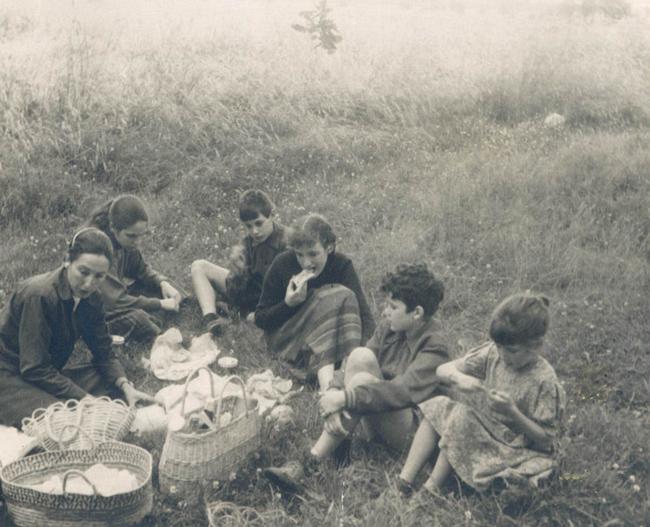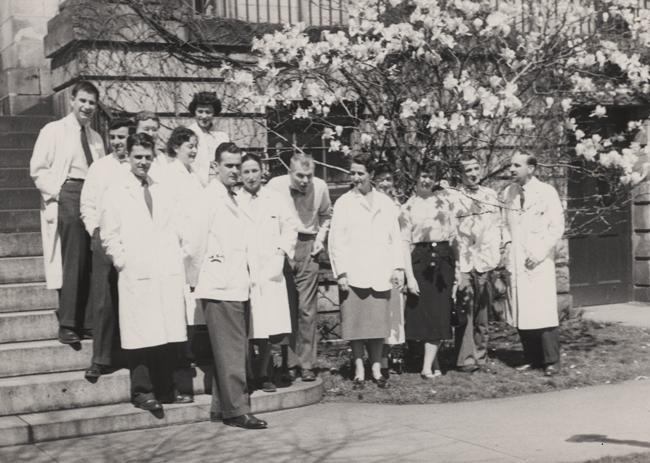A Woman's Work
Anne Pappenheimer Forbes helped shape the field of endocrinology—while mentoring several HMS alumni
- 11 minute read
- Profile

Anne Pappenheimer Forbes astride one of her horses
When they moved into their home in Milton, Massachusetts, Anne Pappenheimer Forbes and her husband, William, were only a few years into their marriage and fresh from stints at Johns Hopkins: Anne, known nearly universally as Nan, as an intern at Johns Hopkins Hospital, and Will, as a medical student.
“We returned to Boston,” wrote Nan to Radcliffe classmates for their twenty-fifth reunion, “to a large wooden family mansion which had not been put in order since the nineteenth century and has not been yet.” The Victorian house had been in Will’s family for three generations; it would become Nan and Will’s home for the remainder of their lives. In it, they would rear five children. Around it, the family would, at various times, raise cows, pigs, chickens, horses, and sheep. Into it, Nan and Will would welcome friends, family, and, over the years, more than a few HMS or international trainees. From it, they would commute to their work: Will to the Harvard Fatigue Lab and later to what was then the Harvard School of Public Health; Nan, for a brief period, to the former Children’s Hospital, then to the endocrinology laboratory of Fuller Albright ’24 at Massachusetts General Hospital.
Nan would stay at Mass General for four decades. There, often the only female member of the endocrine unit, she would conduct clinical research and mentor interns and fellows who were new to endocrinology. Many of those young men, including Daniel Federman ’53 and Mitchell Rabkin ’55, eventually achieved their own distinctions in medicine. But Nan, too, achieved recognition. She was only the third woman at Mass General to earn the rank of clinical professor; while at HMS, she was the ninth women to earn this rank. Her research accomplishments led to her being named one of the first woman members of the American Society of Clinical Investigation and to her papers being included in the Archives for Women in Medicine at the Francis A. Countway Library of Medicine.
Respect for Nan has not diminished. Robert Neer, an HMS associate professor of medicine at Mass General and a research fellow in medicine there in the late 1960s, recently recalled Nan as being “extremely intelligent, fiercely independent, and fearlessly truthful.”
The Prepared Mind

Although Nan’s life was a demanding one, it was one for which she was well prepared. She was born in New York City on November 11, 1911, into an affluent and intellectual family. She received a good education and developed an appreciation of music and the visual arts and a passion for travel. Her father, Alwin Max Pappenheimer, a physician, had interned at Bellevue Hospital before becoming a professor of pathology at Columbia College of Physicians and Surgeons. Nan’s mother, Beatrice Leo, was a talented pianist who made sure Nan and her brothers, Alwin Max Jr. and John Richard, appreciated music.
During World War I, Nan’s father enlisted in the U.S. Army, eventually becoming a lieutenant in the Medical Reserve Corps. In April 1917, he became director of laboratories in his unit, which was preparing to deploy to France. The twenty-one months he was gone were difficult for the tight-knit family. Nan, in fact, feared she would never see her father again.
In 1922, Nan’s parents took the children through Belgium, Germany, Holland, Norway, and Sweden, and to some of the battlefields of France, still furrowed with battle trenches. While in Paris, the children were enrolled in school, the boys in the École alsacienne, a private school for boys, and Nan in a lycée for girls.
Trains and Boats and Automobiles
Upon returning to New York City, Nan attended the Lincoln School, a school founded in 1917 as “a pioneer experimental school for newer educational methods.” During her interview at Radcliffe, Nan said she liked everything at Lincoln, including such extracurricular activities as horseback riding and writing for the school paper. Her plans after college, she said, were medicine or farming.
When, at age 16, Nan entered Radcliffe, it was a liberal arts women’s college referred to as the Annex. Although it was an institution separate from Harvard College, its students were taught by Harvard professors who repeated their lectures on the Radcliffe campus.
As Nan explained to a colleague years later, she was such a rebellious girl that before her senior year her parents took her on a pedagogical and therapeutic trip around the world starting in 1931. Leaving New York, they spent six weeks in Russia before boarding the Trans-Siberian Railway to Manchuria, then traveled to China and Singapore and to regions then known as Siam and Indochina, before sailing from Hong Kong to San Francisco. They then purchased an automobile and drove across the United States, arriving in New York in February 1932, in time for Nan to start the spring semester.
The trip seems to have served its purpose: Nan was ready to complete her studies. “With two summers at summer school,” she reported to her classmates, “I made up the lost time.” One of the summers was spent studying biochemistry at the Woods Hole marine biology station, a spot familiar to her since childhood. Her father had spent several summers there doing research, and her mother had been instrumental in creating a vacation school for children eager to study science. Nan and her brothers had been students there when they were young.
During summer school, Nan took a biochemistry course; it was her first serious experience with research. In 1933 she graduated cum laude from Radcliffe, simultaneous with completing her first year at Columbia College of Physicians and Surgeons.
Nan and Will married in December 1935, just months before her graduation from medical school.
A Sense of Place

By the time Nan joined Albright’s endocrine unit, first as a volunteer and then as a research fellow, he had already made numerous discoveries and had a group of young doctors assisting him in clinical research. Rounds took place daily at 11 a.m. for every medical attendant and every patient in Ward 4, a ten-bed research unit where patients and healthy participants were intensively studied.
Nan fit well into the group. Intelligent, sensible, and calm, she became Albright’s “physician administrative chief and collaborator,” relieving him of some of the administrative tasks that went with clinical studies. When the United States entered World War II, everything changed. As Nan explained in a Radcliffe reunion report, “the armed services took all his staff, and I became his only (hence invaluable) assistant.”
In 1941 she was second author on a paper on hypoleydigism in Transactions of the Association of American Physicians and third author on a methods paper in the Journal of Clinical Endocrinology, which described a colorimetric assay of 17-ketosteroids in urine. In 1947 in the same journal, she debuted as a first author on the paper “The effect of trauma and disease on the urinary 17-ketosteroid excretion in man.”
Nan conducted studies on a variety of clinical syndromes including one that ultimately carried her name: Forbes-Albright syndrome. Her careful observation of pituitary tumors associated with amenorrhea and galactorrhea convinced her that there must be a human prolactin responsible for the disease, as was later proven.
Albright was so convinced of Nan’s exceptional talent that he nominated her to become a “Young Turk” in the American Society of Clinical Investigators. Albright wrote, “Dr. Forbes has been associated with my research team for seven years. She has contributed a large amount of work and you will find her at the back of many of the better ideas which we have had. She ranks triple A on originality.” Nan became a member of the society in the early 1950s, while still a research fellow in medicine at Mass General. In 1977, Nan was promoted to clinical professor of medicine.
During the next several decades, Nan pursued her clinical research and, according to the Countway’s archive, published articles, abstracts, monographs, and editorials on gonadal disorders, pseudohypoparathyroidism, dermatoglyphics, amenorrhea, pituitary tumors, kidney stones, bone diseases, and the connection between menopause and osteoporosis.
On the Road
Nan and Will took the family on extensive overseas trips, including a year in Paris during Will’s appointment as science attaché at the U.S. Embassy. While there, Nan enrolled the children in the École alsacienne, the same school her brothers had attended twenty years earlier, and embarked on her own research concerning male testicular deficiencies.
To help the children acclimate to their temporary school, Nan joined them for picnic lunches and used the time to counsel them on ways to cope in the sometimes difficult environment. At the end of the school year, Nan and Will took the children on a car trip in Northern Europe. Upon returning to the United States, Nan published her research on testicular function in 1957.
Thirteen years after their time in Paris, Nan spent two years in Shiraz, Iran, where Will had an academic appointment and where she had been appointed assistant professor of medicine at Pahlavi University Medical School. There she taught endocrinology to medical students and researched skeletal maturation in Iranian children.
Investing in the Future

According to Nan and Will’s children, their home was a lively place where Nan ferried children to school in the morning and did the cooking in the evening but left dishes in the sink for the household helper to do the next morning. These many years later, the children admit they were happy their mother had a hospital job to absorb some of her prodigious energy. When her mind was not occupied with endocrinologic challenges and children, she raised sheep, rode horses, spun wool, knit, and painted some of the home’s interiors. Various observers and family members acknowledged a degree of domestic chaos but observed nothing of the sort in her academic work at Mass General. She and Will had what the children describe as a warm relationship in which Will supported Nan’s interest in pursuing a demanding but fulfilling career in endocrinology.
When asked how she managed to teach, do research, write papers, take care of patients, and still participate in the lives of her children, Nan’s children ventured that her summer schedule allowed her to concentrate on endocrinology from Monday through Friday while the young ones swam, rode horses, and sailed on Naushon Island under the watchful eyes of a babysitter, a grandmother, and a housekeeper and cook. During those periods, Nan and Will caught a 5:45 p.m. boat from Boston to Naushon Island on Friday, arriving with fresh milk from the family cow. They returned to Boston on the 6:30 a.m. boat on Monday. The children recall these three months each year as being among the happiest of their childhood.
They also recalled a number of unusual birthday parties in which their mother introduced a mouse into the festivities. Each guest was asked to build a mouse house out of construction paper, insert a piece of cheese, and place the house inside a large, open-topped box. The mouse was then set loose in the box. Whichever child’s house it entered first won a prize for the builder. That house was then removed and the mouse was again let loose. This sequence was repeated until the mouse had visited every house, and every child had won a prize. The mouse was returned to the Mass General laboratory the following day.
In 1978 Nan retired and became an emeritus clinical professor of medicine at HMS. In her report in her Radcliffe class’s sixtieth reunion booklet, Nan wrote, “Retiring after forty years of medical practice I stayed home to care for my husband, who was developing Alzheimer’s disease and to tend to a large garden … [I also] undertook a job which I highly recommend to other grandmothers; that of providing day care for grandchildren whose mothers work. It is not true that working mothers are not good mothers, but the children are small just when their mothers are hardest pressed … I gave the children stability and security, while they kept me productively busy, needed, and appreciated.”
In February 1992, Anne Pappenheimer Forbes died of Hodgkin’s lymphoma. Her eldest grandchild, Adam, in his tribute to his grandmother, quoted the last lines of Tennyson’s Ulysses:
Made weak by time and fate, but strong in will
To strive, to seek, to find, and not to yield
It was, Adam noted, a most fitting epitaph.
Amalie Kass is a lecturer on the history of medicine in the HMS Department of Global Health and Social Medicine and the former chair of the Board of the Massachusetts Historical Society. Eleanor Shore ’55 is senior consultant to the HMS Office for Academic and Clinical Programs and the former chair of the Archives for Women in Medicine at the Francis A. Countway Library of Medicine.
Photos: Courtesy of the Forbes family; The Francis A. Countway Library of Medicine (Albright lab group photo)